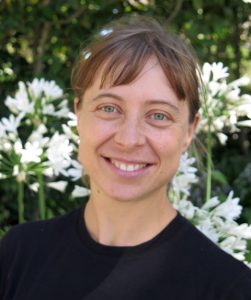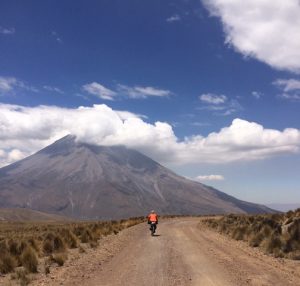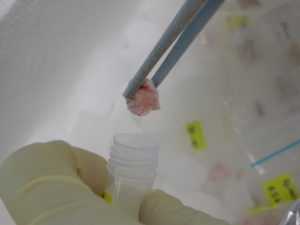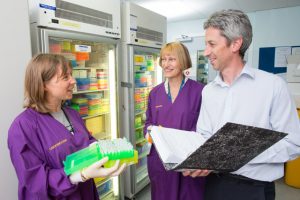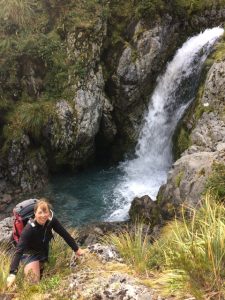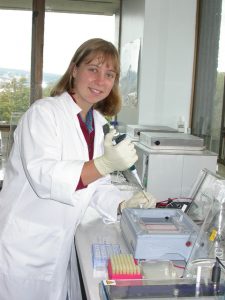We live in a nation where you can turn up to your GP, be screened for a range of Cardiovascular risk factors, and your GP can determine whether there is, say a 5%, or 20% chance that you may go on to have a heart attack in the next five years. Your doctor might recommend some lifestyle changes, and prescribe a blood pressure lowering medication. This may reduce your chance of having a heart attack, but there is no way to know whether you will actually go on to have one.
Now imagine a world where your GP can test you for a certain molecule, or combination of molecules (perhaps genetic material in the blood, or a DNA marker in your cells), and the presence or lack of this ‘marker’ can accurately predict whether you are going to go on to have a heart attack or not. And if you have already had a heart attack, you could be screened for similar ‘markers’ that can better predict your long-term prognosis.
This is the goal of Dr. Anna Pilbrow of the Christchurch Heart Institute. More specifically, she is interested in inherited susceptibility to heart disease. Anna recalls having an interest in medicine, and particularly heart disease, from a young age. Three of her four grandparents passed away within the space of a couple of years, from heart-related issues. This, she recalls, perhaps created a subtle awareness of the presence of heart disease in her family. Anna was a budding young thinker, winning the National Science Fair Technology category in 1997. Her project was a continuous ready-to-serve hard-boiled egg—think a cylindrical device that lets you hard-boil eggs, such that there is the perfect amount of yolk-to-egg ratio in every slice!
Anna recalls these early experiences leading her in the direction of research, triggering her to do a biochemistry degree at Lincoln. Biochemistry—because it combines chemistry and biology—but also provides the option to take a medical route, which had always interested her. In her third year, she transferred to Otago to complete her undergraduate degree. Anna then had her first exposure to the Christchurch Heart Institute when she did a summer studentship under the supervision of Professor Vicky Cameron.
Anna then went on to do an honours degree at Otago University. Anna recalls her supervisors from this time, Warren Tate and Joanna Williams being instrumental in her success. She recalls her education as being surrounded by “wonderful projects and people”. By this time, she felt a break from study was necessary, and thought “time to earn some money!” She spent nine months working as a research technician, and eventually thought “maybe I would like to lead my own research” and “maybe I will need to do that PhD after all!” She ended up doing a PhD with the Christchurch heart institute, and did a couple of years as a post-doc there, as well as a couple of years in San Diego.
Research
Anna’s research is fascinating. Her passion for her work is evident in her explanations, and her expertise is clear in her ability to explain the content of her research. You are most likely aware that many things contribute to your heart disease risk: environmental factors, your age, whether or not you smoke, your diet, exercise, etc. On top of all of that are your genetics—what you inherit from your parents. These lifestyle and genetic factors interact to generate your overall risk, but Anna is really just focusing on the genetic side. The aim of her research is to discover new markers that help us predict either: who is about to have a heart attack, or, in patients with established heart disease, who goes on to do better or worse.
Anna’s Dream
The idea is that somebody can turn up to their GP, and the GP will screen them for a range of cardiovascular risk factors (age, gender smoking, diabetes, blood pressure, cholesterol—they will measure all of these). From this, they can predict whether or not someone’s got say a 5%, or 20% chance of having a heart attack in the next five years.
Currently, this only works really well on a population level, so if the doctor sees a hundred patients, and a certain amount of them all have a similar risk profile, you can say there is a 10% chance of that group of individuals having a heart attack in the next five years. They will all be treated the same. For example, the doctor might recommend some lifestyle changes, and prescribe a blood pressure lowering medication. But what we find is that within each group of risk, there is a proportion (say 10%) that will still go on to have a heart attack. That means 90% do not, but they are all treated the same, regardless. So, Anna explains her dream is to find a molecule—whether it is some genetic material that floats around in the blood that we can measure, or whether it is a DNA marker that is just in our cells—the idea is to find something that can help tease apart who is going to actually go on to have that heart attack, and who is not. The idea is to add value on top of our current predictors, to predict better on an individual level what will happen to that individual. The parallel is once somebody has a heart attack; we can predict who is likely to do better or worse. Currently, we do not get that prediction right all the time, and we could improve it by adding some other markers.
Not Junk After All
In the last ten years, we have realised that most of our inherited susceptibility to complex diseases like heart disease, cancer, and Alzheimer’s, is not where we thought it was. If you think about DNA as a big long string, our genes are spaced along the DNA, but there are also long gaps of genetic material between the genes. Up until recently, we did not have a good idea of what it did. It was originally termed ‘junk’ DNA. But there have been some big advances in technology that have enabled very large studies to be undertaken. These “genome-wide association studies” look at most of the common variations in our DNA, within an individual, in a single experiment. Most of our DNA is the same, however, there are certain specific points where we vary. In a single experiment, we could work out what those points were for you. We could do it for me as well. But if we do it in ten thousand people, half of whom have heart disease and half of whom do not, we can compare the frequency of those variants between the two groups. The variants that are more common in the disease group than the healthy control group, are the bits of our DNA that are contributing to our inherited susceptibility for those diseases.
These types of studies have been done internationally over the last 10 years or so. We now have a good idea of the points of our DNA that are contributing to our inherited susceptibility to heart disease. “Where we had been looking for years was in the genes,” Anna explained, “but it’s not in the genes! It’s in these long spaces of junk DNA between the genes. So very quickly we’ve thrown out the word ‘junk DNA’! Because it’s clearly not junk! It’s clearly doing something.”
This DNA is not coding for protein, that is what the genes do. It turns out that these long gaps of non-coding DNA code for other molecules. They can code for RNA molecules for example. We traditionally thought: the genes are in the DNA, you make the working copy of the DNA out of RNA, and this then gets translated into the proteins. It turns out that there is another RNA that is made from these non-coding regions. It does not get made into protein, but it goes about and does other things. One of these things is regulating how the protein-coding genes are made.
I asked Anna if there is one question relating to her research, she would most like answered, she explained “what I would like to know is the mechanism by which the DNA variants of the non-coding parts of the DNA are working. What are they doing, that then goes on to increase our risk of heart disease? Or even Alzheimer’s or cancer. 95% of our inherited susceptibility lies in the ‘junk’, so what is it doing? That is what I want to know.”
Regulation, COVID19, and Science Distrust
We live in a society that looks to science for solutions to our complex issues, as the scientific method has arguably been the single most important tool in the evolution of human society. Yet, we also live in a time where science and scientists are met with mistrust and undue scepticism. While scepticism and peer review are vital components of the scientific method, it can often be difficult for laypersons to know how to go about identifying false information, and how to apply good scepticism. In discussing this with Anna, I asked what she thinks the most important thing to keep in mind when considering complex or even simple science-based issues, particularly in relation to COVID-19.
“To me, [COVID has] been the most amazing example of how the value of science has really been showcased. Here in New Zealand, we have Dr Ashley Bloomfield standing side-by-side with Jacinda. Here was a scientist, leading our national response, supported by a huge team of epidemiologists, computer modelers, infectious disease control experts, academics, government employees, etc. To me, that was a great example of how the value of all of those years of research and knowledge all came together and came up with a really powerful response to a potential health disaster. I do not know if that answers what the public needs to know. But when there is uncertainty it is helpful if scientists and the government can deliver a single clear message. That is what the public needs in order to get behind something.”
Mentors
One of the themes of Anna’s academic and professional career has been good mentors. Anna explains that her career has been driven largely “by serendipity and people.” Throughout our interview, Anna mentioned many people who helped her in some way, get to where she is today. She remembers Mr. White from her first year of primary school, an absolutely gifted teacher who brought together kids from all walks of life. She also remembers her form one and two teacher, Mr. Fowler, who was incredibly strong in teaching mathematics (up to her twenty times tables, she recalls), but also poetry, and he had an amazing class cricket rounders team!
She credits her first supervisor from her summer studentship at the Christchurch heart institute, Professor Vicky Cameron. Her honours project looking at synapses in the brain, supervised by Warren Tate, and Joanna Williams was also instrumental in her professional development.
When I asked Anna if she recalls the best advice she has been given, she struggled to come up with a single best piece of advice but instead credited those who are always there to advise her. “What I will say is that I have been incredibly lucky to have good mentors all the way through. Vicky for example has been a real key mentor. Beyond her, there have been others at the Christchurch Heart Institute, others at the school of medicine, my former supervisors, and peers, who have been very supportive and helpful along the way. I think it is only through them that I have been able to find a good path. So, my best advice would be finding smart, intelligent, amazing, and dynamic people to surround yourself with.”
This is one of the great qualities of a scientist, to be able to learn from those more experienced than them. An equally good quality is intentionally taking the time to pass on your skills, experience, and expertise to aspiring researchers. This is one of Anna’s goals, when I asked her what she would most like to be remembered for she did not hesitate:
“I want to give back”
Written by Don Sinclair
Images Supplied by Anna Pilbrow

